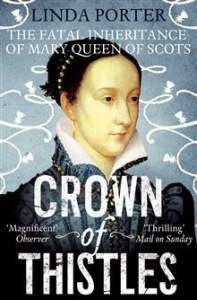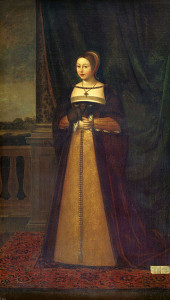Crown of Thistles: The Fatal Inheritance of Mary Queen of Scots (or in the US Tudors vs. Stewarts: The Fatal Inheritance of Mary Queen of Scots)
By Linda Porter

In the course of my hiatus, I had the opportunity to read a few books that’d been on my “want” pile, and at the very top was Crown of Thistles, which I purchased on my trip to England earlier this summer. I’d already read the other “fun” book I purchased at the same time, a biography on Queen Matilda, whose husband was King William I of England. I’d wanted to get one in temporal area of research and one out. I was quite pleased to find one that seemed to be about Mary Queen of Scots, mother-in-law to Anna of Denmark, whom I presented a paper on this summer.
After presenting and having the opportunity to talk shop about history with the other presenters, I’ve become more resolved to look at not just English history, as I’ve done previously, but also Scottish. Scottish history is a rich and vibrant field and I want to continue my study looking at royalty, the construction of feminine identity and authority, and educational history, especially in context of the other monarchy on the island and in relation to those on the continent.
So this book Crown of Thistles, fits in quite well with my geographic focus and my focus on royal studies. Originally, from the title, I thought it was primarily going to be about Mary Queen of Scots, and a focus on her relationship with Elizabeth I of England, but I was mistaken. From the start, I was annoyed that we were reading about Catherine de Valois, Queen Consort to Henry V, and James III, but I was drawn in to Porter’s prose with her flair for bringing these historical characters to life as flesh and blood people and realizing where she was going by starting so far in the past.
By starting in the 15th century, she carefully sets up the tempestuous relationship between the two dynasties, and then carefully gives us background and biography on each of the rulers and other main players in the government and society. I was glad, it was a breath of fresh air, to read about Scottish monarchs James III, James IV, and James V.
Also written in great detail was the Battle of Bosworth Field, as well as the rest of Henry VII’s exile and battles for the throne.
Pulling together these two seemingly disparate threads to put light on Mary Queen of Scots and Elizabeth was an interesting approach, and although I’d wanted more on Mary, there are other sources which fall under that heading, like Lady Antonia Fraser’s work, or John Guy’s. This put her childhood in France in context with the ambitious nature of her mother and brought to life the Auld Alliance. As a reader, she helped me to understand that while the story can seem simple, it is infinitely more complex than it seems, and to bring an understanding of the people, as living-breathing people, can grant the reader more clarity.
I would whole heartedly recommend this book, with the caveats that it is 1) not just about Mary Queen of Scots, and 2) for a trade paperback, REALLY long. It reads quickly and is not overly difficult.




